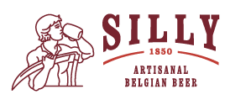In a previous issue we gave an account of the history of Brasserie de Silly from our birth in 1850 to 1930. Now it’s time to move on to the next chapter.
In 1937 the Meynsbrughen family purchased the buildings of the former village school in Silly to install the brewery’s first bottling plant. Adelin Meynsbrughen cashed in on the increased production capacity with two new beers: Sylla (a bock type) and Export. These newcomers joined a range that included table beers (a low-alcohol style designed to be drunk with food) as well as a saison, a grisette, a scotch and a spéciale belge – all top-fermented beers.
At the beginning of the Second World War the brewery expanded by adding a small malt works. But in 1944, a lorry tarpaulin hanging out to dry in front of the building started a fire, and that was the end of that.
From 1947 brewing gradually continued to take over from the Meynsbrughen family’s farming business. They continued to produce only top-fermented beers until 1948, when Adelin’s brother-in-law, José Van der Haegen, the husband of Josette Meynsbrughen, introduced the first bottom-fermented beers.
A triple bock was introduced in 1950, accompanied by an Export that was a complete revamp of its pre-war namesake. In 1956, Myn’s Pils entered the scene, and in 1964 Adelin developed the new Super 64, an amber-coloured, top-fermented beer with 5.2 % alcohol by volume.
Adelin passed away just a few months later after a career of almost 60 years at the head of the brewery.
By the early 1970s Jean-Paul and Didier, the sons of José and Josette Van der Haegen, had taken on the brewery’s management. Jean-Paul was the main brewer, while his brother worked as sales director and PR manager. In 1972 Jean-Paul perfected a blond, bottom-fermented beer that he named, Silbrau Dort. The production of Export ceased not long afterwards.
The brewery changed its name in 1973, becoming Brasserie de Silly. In 1975 the brewery took over Brasserie Tennstedt Decroes of Enghien (Edingen) and incorporated its Double Enghien city beer into the Brasserie de Silly range. There are still three versions of this classic on the market: a blonde, a dark and a Christmas beer.
To be continued…

